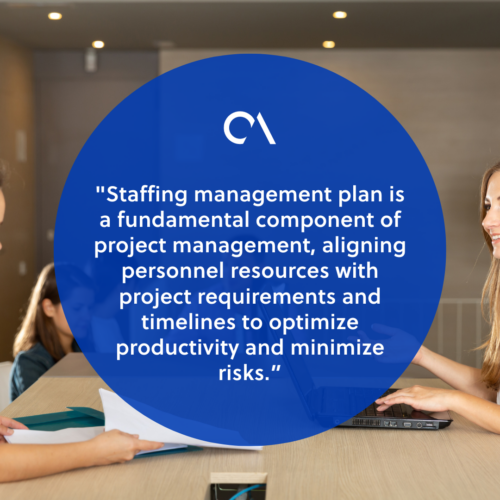What is a staffing management plan?

Ensuring the right people are hired at the right time is vital for the smooth functioning and success of any business.
Businesses that hire individuals who are not suitable for the roles can lead to decreased productivity, missed deadlines, and compromised quality of work.
Additionally, employing the wrong people may also result in increased turnover rates. Employees may feel disengaged if they are not a good fit for their positions or the company culture.
High turnover not only incurs additional costs for recruitment and training but also disrupts team dynamics and overall morale. This is where a staffing management plan comes into play.
Defining a staffing management plan
A staffing management plan is a strategic document that outlines how human resources will be procured, utilized, and managed to fulfill project objectives efficiently and effectively.
It is a fundamental component of project management, aligning personnel resources with project requirements and timelines to optimize productivity and minimize risks.

What does a staffing management plan include?
A robust staffing management plan encompasses various elements crucial for resource optimization and project success.
Staffing needs assessment
Under this section, several key elements are addressed to ensure that the organization’s human resource requirements are thoroughly evaluated and met.
This involves conducting a comprehensive analysis of the current workforce composition, including an assessment of skills, experience, and qualifications.
Additionally, the staffing needs assessment covers forecasting future staffing requirements based on the organization’s strategic objectives and anticipated changes in workload or demand.
This forward-looking approach enables the organization to proactively plan for future staffing needs and avoid last-minute hiring decisions.
Staffing timeline
The staffing management plan should outline specific milestones or project phases that necessitate adjustments in staffing levels or skillsets.
Identify key deliverables and deadlines throughout the project lifecycle to anticipate when additional personnel may be required or when certain roles may become redundant.
This shift necessitates reevaluating compensation strategies and considering factors such as cost of living and industry standards. Implementing a GPS time clock for your business can aid in accurately tracking remote employees’ hours and locations, ensuring fair compensation and compliance with labor laws regardless of their geographical location.
Moreover, the staffing timeline should detail the duration and sequencing of recruitment activities, including sourcing, screening, interviewing, and onboarding processes.
Performance management
Within the framework of performance management, the staffing management plan includes two initiatives:
- Setting clear performance expectations and objectives for employees
- Outlining the specific goals they are expected to achieve within a given timeframe
This clarity helps employees understand what is expected of them and provides a roadmap for their performance.
The staffing management plan must incorporate strategies for recognizing and rewarding high performance. This may include incentive programs, bonuses, or other forms of recognition to motivate employees and reinforce desired behaviors.
How to create a staffing management plan
Crafting a comprehensive staffing management plan entails a systematic approach encompassing the following steps:
Understand project requirements
To begin, project managers must thoroughly analyze the specific needs and objectives of the project.
This involves identifying the scope of work, deliverables, and timelines, as well as any unique challenges or constraints that may impact staffing requirements.
Project managers should engage stakeholders and subject matter experts to gain a comprehensive understanding of the project’s technical, functional, and operational requirements.
Conduct resource assessments
Conducting resource assessments is a critical step in creating a comprehensive staffing management plan. This process involves evaluating the current resources available within the organization, including human resources, equipment, technology, and facilities.
It’s crucial to identify the specific skills, expertise, and competencies required for each project or task. This entails assessing the workload and scope of work to determine the optimal number of staff members needed and the skill sets they should possess.
Determine staffing needs
Ensure that the right number of employees with the appropriate skills are available to meet the demands of projects and operations.
Additionally, considering factors such as seasonality, industry trends, and potential growth opportunities can help anticipate future staffing needs.
Collaborating closely with department managers and project leads can provide valuable insights into the specific skills and expertise required for each role.
Once the staffing requirements have been identified, it’s important to prioritize them based on urgency and strategic importance.
Provide training and development
Once you have the right staff members, you should determine the most effective training methods based on the learning preferences and logistical constraints of the workforce.
This can include a combination of in-person workshops, online courses, on-the-job training, mentoring, and external seminars or conferences.
By offering a variety of learning opportunities, organizations can cater to different learning styles and ensure maximum engagement and retention among employees.
Additionally, a firm like Offshore MVP specializes in fulfilling your offshore staffing needs.

Benefits of having a staffing management plan
Having a staffing management plan offers numerous benefits for organizations undertaking projects that require the coordination of human resources.
Some of the key advantages include:
- A staffing management plan helps organizations allocate human resources efficiently and ensures that the right people are assigned to the appropriate tasks.
- Anticipating staffing needs and identifying potential risks allows organizations to address challenges that may arise during the project lifecycle proactively.
- A well-executed staffing management plan ensures that projects are adequately resourced and staffed, leading to the timely delivery of quality outcomes.
Overall, regularly reviewing and updating the staffing management plan enables organizations to adapt to changing project requirements, resource availability, and stakeholder expectations.
This iterative process fosters continuous improvement and optimization of staffing practices over time.







 Independent
Independent




